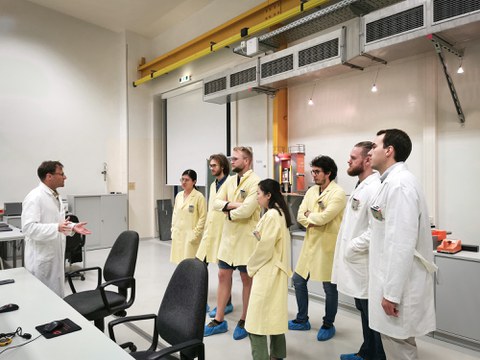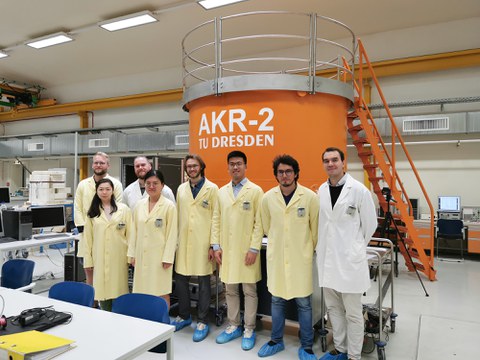Sep 02, 2022
RTG visits the training nuclear reactor and new research building of TU Dresden
On September 1st, 2022, the doctoral students of the Boysen-TU Dresden Research Training Group (RTG) had the opportunity to visit two facilities. The program started with the inspection of the training nuclear reactor (AKR-2) of the TU Dresden in the Walter-Pauer-Bau under the guidance of Dr. Lange (Chair of Hydrogen and Nuclear Energy/ WKET). After a short break, a guided tour by Prof. Lippmann and Mr. Findeisen (also WKET) followed through the new research complex at the Merkel-Bau with the associated laboratories.
Arriving at the first inspection station in the Walter-Pauer-Bau, and after a safety briefing, the exact functioning as well as the construction of the reactor were explained by Dr. Lange (WKET). For a better understanding of the participants, a demonstration of the reactor interior was given on the basis of a model. The differences to a nuclear power plant, which is used to generate electricity, were also shown. The participants followed with interest Dr. Lange's explanations of molten salt reactors, which are still being researched and which have clear advantages, particularly in the areas of waste production and energy utilization.
Afterwards, the process of reactor start-up was discussed and demonstrated simultaneously. The doctoral students not only learned more about the individual steps to be performed, but also details about the reactor's safety precautions, such as neutron detectors, a neutron shield and a gamma shield. A reactor rapid shutdown system (RESA) makes it possible to shut down the reactor quickly. Dr. Lange reported on the history of the origin of the English acronym "SCRAM" as a translation of RESA. The English term stands for "safety control rod axe man" and originates from the operation of the first reactor. During the rapid shutdown demonstration at that time, an assigned person held an axe. In an emergency, a string was to be cut, at the end of which hung a vessel containing an absorber liquid that would have stopped nuclear fission immediately when poured into the reactor core.
The training nuclear reactor at the TU Dresden, which is part of the Center for Energy Technology (CET), is a thermal, homogeneous, solid-moderated zero-power reactor. The reactor is used, among other things, for the education of students, the further training of technical personnel, and the performance of experiments, especially in the field of neutron radiography. Six experimental channels are attached to the reactor for this purpose.

Dr. Lange (left) captivated his audience with vivid explanations.
Afterwards, the participants were able to marvel at the new research building at the Merkel-Bau. Prof. Lippmann and Mr. Findeisen guided the members of the RTG through the different rooms and laboratories, where the current research projects were explained, e.g. the development of lasers for the removal of pollutants. In addition, a description was given of the machines which are to be integrated into the new research building in the near future. Planned are, for example, the installation of a high-temperature electrolysis, which, in contrast to the currently commercially available devices, will work with a proton-conducting membrane, or also an alkali metal converter for the direct conversion of heat into electrical energy.
We would like to thank Dr. Lange, Prof. Lippmann, and Mr. Findeisen for their time and the exciting, very informative insights!

